
RECIPES
Page 4
RECIPES INDEX
BACK TO TABLE OF CONTENTS
TROUT AND CAPER PIE WITH PERNOD
This pie is made with puff pastry. For ease you can buy it pre-made, alternatively there are plenty of recipes on the Internet if you feel the need to do-it-yourself. You will need about half a kilo of pastry and let it chill for a short while in the fridge before use.
Trout - 2 small whole fish about 500g each, cleaned
Olive oil - a dash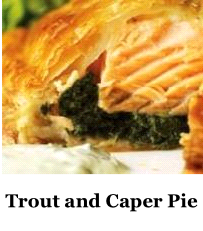
Butter - 50g
Medium onion - ¼ finely chopped
Celery - 2 slender sticks trimmed and finely sliced
Pernod - 3 tbsp
Plain flour - 40g
Whole milk - 400ml
Double cream - 4 tbsp
Tarragon - 2 sprigs, leaves finely chopped
Curly parsley - handful finely chopped
Baby capers - 3 tbsp rinsed and drained
Ground white pepper and Sea salt
Preheat the oven to 225C/gas 7. Melt the butter in a medium sized non stick saucepan using a low heat. Gently fry the onion and celery and add the Pernod. Cook gently for 8-10 minutes until soft but do not allow to colour, stirring occasionally. Next, sprinkle the flour into the pan and cook for a few seconds before whisking in the milk a little at a time. When all the milk is added cook for a further 10 minutes, stirring continually until smooth and glossy. Remove from the heat and stir in the cream, tarragon, parsley, capers and seasoning. It may need more salt than you would expect to bring out the taste. The sauce now needs to cool for 30 minutes and place some cling film directly onto the surface of the sauce to prevent a skin forming.
The fish needs to be partially cooked before baking in the pie. Line a small baking tin with foil and brush with olive oil. Put the trout in the foil and cover with a second piece of foil, folding the edges to make a parcel. Bake for 15 minutes and then leave to stand for 20 minutes without opening. Open the foil and remove the skin from the fish. Lift the fish in large pieces and place in a bowl, leaving the bones and other bits behind. Flip the fish over and take the flesh from that side. Tip any juices into the white sauce. Using 1.5 litre pie dish, spoon a little of the sauce in the bottom of the dish and place a few pieces of fish on top. Repeat and continue layering until filled.
Roll out the pastry on a floured surface until about 2cm larger than the pie dish. Brush the edges with beaten egg to form a seal and place over the filling. Trim with a sharp knife and pinch up the edges. Lightly score a large cross hatch across the top and brush with the egg. Bake at 200C/gas 6 for 30-35 minutes until the crust is golden brown. Keep an eye on it while it cooks to make sure the crust does not burn. Ensure the filling is piping hot before serving. Serve immediately.
***
Next something that looks great as a centre piece for a dinner party. This recipe serves 10 but the quantities can be adjusted according to your number of guests. Trout can also be used in this recipe but you will need to use large fillets. To cheat, you can make this up to a day ahead, cook and then reheat it when required. It can even be prepared and frozen, uncooked, for up to a month - just make sure it is completely thawed before cooking.
SALMON EN CROÛTE
Salmon fillets - 750g (1 lb) skinned and boned (including the pin bones)
Smoked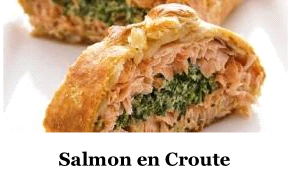 salmon - 100g (4oz)
salmon - 100g (4oz)
Egg white - of 1 egg
Fresh dill - small bunch finely chopped
Capers - 100g (4oz) drained and roughly chopped
Crème fraîche - 250ml (10oz)
Puff pastry - 450g packet
Egg - 1, beaten
Sea salt
Black pepper - freshly ground
Trim the salmon/trout to equal sized blocks so that they can be stacked. Put the trimmings from the fish and the smoked salmon, together with the egg white, dill, capers, crème fraîche and some seasoning in a processor and whizz to a smooth paste. Place in the fridge to chill for an hour.
Roll out the puff pastry to a large rectangle, enough to encase the salmon and place it on a large greased baking sheet. Place the salmon/trout in the centre of the pastry, building the fillets into a brick shape. Now spoon the chilled paste onto the top of the salmon. Brush the beaten egg along the edges of the pastry and fold the long edges of the pastry up to the top of the salmon brick. If necessary trim off any excess pastry, leaving just a half inch overlap along the top. Gently press it together to completely enclose the brick. At either end cut off any excess pastry so that an inch or so overlaps and sits on the baking sheet. Crimp these edges with a fork.
You should now have a tight loaf with the fish snug inside. Place the loaf in the fridge for an hour to firm it up. Preheat the oven to 220C/Gas 7. Brush the pastry with the beaten egg and bake in the preheated oven for 30-45 minutes until deep golden brown. Remove from the oven and allow to rest for 10 minutes before serving.
***
Here is something a little special for a starter when entertaining. Again it will work with trout as well as salmon.
POTTED SALMON
Salmon - 500g fresh, skinned and filleted
Goose fat - 1 x 340g can
Sea sal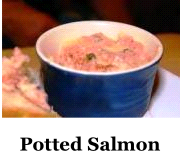 t - about ½ tsp
t - about ½ tsp
Black pepper - freshly ground
Coriander - 2 tbsp freshly chopped
Crème fraîche - 2 tbsp
Classic vinaigrette - 2 tbsp
Cut the salmon into chunks. Melt the goose fat in a medium saucepan, heating gently until just below 100C. This will take about five minutes on a gentle heat but use a temperature probe to get it right or you will end up frying the fish instead of poaching it. Add the salmon and poach gently for about five minutes. The fish should be pale pink and slightly springy when pressed.
Remove from the heat and allow the saucepan to stand for another five minutes. Now lift the fish out of the saucepan with a slotted spoon and transfer it to a bowl. Flake the fish finely with a fork. Mix in 2 or 3 tbsp of the goose fat, season with the salt and pepper and then leave to cool.
When cool, stir in the coriander, crème fraîche and vinaigrette. Spoon the mixture into individual ramekins and chill in the fridge until firm. Serve with toast or fresh crusty bread.
***
This is an ideal hot dish for a party. The fish is pre-cut into portions before cooking, which makes it easy to serve. You can use a trout but it will have to be a large one to get the side of fish large enough. You can make the onion marmalade - I've included a quick recipe for it. Being lazy, I buy it by the jar. Besides, if I'm having a party - I've got better things to do - like testing each bottle of wine!
ROASTED CRUSTED SALMON FILLET
Side of salmon/trout - 1kg (2¼ lb) with skin on
Salt
Pepper - freshly ground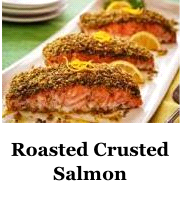
Crumb Topping
Fresh basil - 1 small bunch, chopped
Mild peppadew peppers - 20 from a jar, drained and thinly sliced
Parmesan cheese - 50g (2oz) coarsely grated
Fresh white breadcrumbs - 50g (2oz)
Zest of lemon - finely grated
Onion marmalade - 1 jar OR – if you want to make the marmalade
Olive oil - 1tbsp
Onions - 700g (1½ lb) thinly sliced
Balsamic vinegar - 1tbsp
Onion Marmalade
Heat the oil in a large frying pan or saucepan over a medium heat, add the onions, stir well and season. Cook the onions slowly, covering the dish and stirring from time to time until they are very soft. This will take about an hour and they should become dark, sticky and soft. Add the balsamic vinegar and bring to the boil to reduce the remaining liquid then set aside until cold.
Now the Fishy Bit
Pre-heat the oven to 220C/gas 7 and grease or line a baking sheet. Make sure there are no bones left in the fillet and then sit it on the prepared baking sheet, skin side down. With a very sharp knife cut through the meat until you reach the skin but do not cut through the skin itself. 8 even sized portions should do the trick. Season the fish.
Spread the cold onion marmalade over the fish and sprinkle with the basil. In a bowl mix together the peppers, Parmesan, breadcrumbs and lemon zest. Press the mixture on top of the fish. Bake in the pre-heated oven for 20-25 minutes depending on the thickness of the fish - the flesh should turn opaque pink. Allow to rest for 10 minutes, covered with foil. Serve hot, cutting through the skin of each slice and lifting with a slice.
You can prepare this dish up to the point of cooking, cover in kitchen film and keep it in the fridge for up to 24 hours. Alternatively, wrapped in foil, it will keep for a month in the freezer. Thaw completely before cooking.
***
This recipe is really simple but the sauce makes it a classical offering. It is vital that you don't overcook the fish. Once again, a large trout can replace the salmon.
THAI SALMON
Fresh salmon/trout fillets - 2 x 300g (10oz), skin left on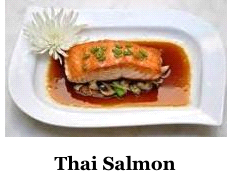
Olive oil
Salt
Freshly ground pepper
For the sauce
Fresh ginger root - 1 x 2.5cm (1 inch) piece
Olive oil - 1 tbsp
Garlic - 1 small clove, crushed
Orange - 1 small
Red Thai curry paste - 1 scant tsp
Full fat crème fraîche - 1 x 300ml carton
Ensure all bones are removed and cut each fillet in half lengthways to make for four people. Brush both sides of the fish with oil and season. Peel the ginger with a potato peeler and cut into needle thin strips lengthways. Using a large based pan will speed up the sauce reduction later. Heat the oil and soften the ginger for 5 minutes before adding the garlic. Stir well, cover and cook on a medium heat for 10 minutes until soft.
Use a zester to remove the zest from the orange and then squeeze the juice into a cup. Now add the Thai paste to the ginger and garlic and stir well. Add the orange juice and the zest and finally the crème fraîche. Bring to the boil and simmer for 2-3 minutes. Add salt to taste. Reduce until a creamy consistency and keep warm.
Pre-heat a non-stick ridged grill pan or frying pan on the hob and place the fish, skin side up on the hot pan and cook for 30-45 seconds only. Now turn on to the skin side and continue cooking for a further 3½ minutes, according to the thickness. Do not overcook, ensuring that the flesh is pink and still juicy. It is easier to return it to the pan if it is still slightly undercooked than try to repair an overcooked fish!
To serve, pour a little of the sauce on each plate and place a fillet on one side of the plate, offering the rest of the sauce separately.
***
Here's a special fish pie for entertaining, the cheese and mashed potato making a light and interesting topping. This recipe is for 12 people. Simply halve the quantities for 6 guests.
SALMON AND FENNEL FISH PIE
Fresh fennel bulbs - 700g (1½ lb)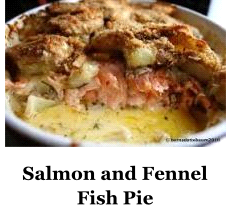
Dry white wine - 300ml (10 fl oz)
Hot milk - about 900ml (1½ pints)
Butter - 100g (4 oz)
Plain flour - 100g (4 oz)
Salt
Freshly ground black pepper
Salmon fillets - 1.4kg (3 lb) skinned and cut into 1 cm ½ inch) pieces
Fresh dill - 2 tbsp, chopped
Eggs - 8, hard boiled and cut into eighths
For the Topping
King Edward potatoes - 1.6kg (3½ lb) weight before peeling, peeled and cut into large chunks
Ricotta cheese - 500g (1lb 2 oz)
Parmesan - 100g (4 oz), grated
Milk - about 8 tbsp
Preheat oven to 200C/gas 6. You will need a shallow ovenproof dish, capacity 1.4 litres (2½ pints), about 28 x 23 x 5cm (11 x 9 x 2 inches). Cook the potatoes in boiling salted water until tender and drain. While the potatoes are cooking, cut the fennel bulbs in half from top to bottom and discard the core. Cut into quarters and then slice into horseshoe shapes. Pop the fennel into a small pan with the wine and simmer until soft, about 10 minutes. Drain, and save the liquid to which is added enough milk to make up to 1.1 litres (2 pints).
Now for the sauce. In a medium pan melt the butter and add the flour and stir to mix. Slowly add the milk and fennel liquid, stirring continuously while it thickens. Season well and then bring to the boil for 2-3 minutes. Add the salmon pieces and cook for a further 2-3 minutes. Stir in the cooked fennel and the dill, check the seasoning again and remove from the heat.
Spread the sauce over the bottom of the dish (you can use more than one dish if necessary) and scatter the eggs over the sauce, pressing them down gently. Mash the potatoes until smooth, adding the ricotta cheese and half the Parmesan plus enough milk to make a creamy texture. Season well. Spoon the mashed potato over the sauce, spreading it right to the edge of the dish. Sprinkle over the remaining Parmesan.
Bake in the preheated oven for 30-35 minutes until cooked through and the top is browned and crisp. If using two dishes try changing their places in the oven half way through to ensure even cooking. You can prepare this dish up to the point of cooking, cover with kitchen film and keep it in the fridge for up to 24 hours, but don't try freezing it.
***
How about a nice easy dish that takes just a few minutes and is equally suitable for parties, easy eating or a semi formal dinner party?
SALMON AND GREEN BEAN RISOTTO (SERVES 4)
Olive oil - 1 tbsp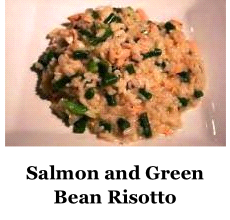
Small onion - peeled and chopped
Risotto rice - 300g
Vegetable stock - 700ml
Fine green beans - trimmed and sliced into 1½ inch (4cm) lengths
Salmon or trout fillet - 300g - trimmed and diced about 1-1½ inch square.
Parmesan cheese - 50g - grated
Black pepper - freshly ground
Heat the olive oil in a pan and gently fry the onions until softened. Add the rice, stirring well to coat each grain with the oil and cook for 1 minute. A little at a time add two thirds of the stock, stirring all the time. Allow the rice to absorb the liquid before adding the next splash.
Meanwhile, cook the beans in a pan of lightly salted water for 5 minutes and then drain.
When you have added two thirds of the stock, add the salmon, the cooked beans and the rest of the stock.
Continue cooking gently until the rest of the stock has been absorbed and the fish is cooked through. You can tell when the fish is cooked because it will flake easily when you try to separate it. Finally, when ready to serve, fold in the parmesan and season with freshly ground black pepper.
***
This is a salad recipe with a difference - bringing together several surprising elements.
CRISP SKINNED SALMON SALAD WITH GREEN GODDESS DRESSING
Pink grapefruit - 1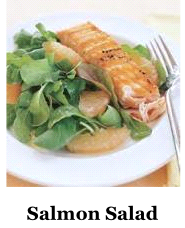
Salmon fillets - 4 x 120g, with skin
Extra virgin olive oil - 1tbsp
Green beans - 100g, topped and tailed
Fresh watercress leaves - 2 large handfuls
Fresh flat leaf parsley - 1 large handful
Fresh mint - 1 large handful
Avocado - 1 well ripened, sliced
Sea salt
Fresh ground black pepper
Green Goddess Dressing - see below
Using a very sharp knife slice off both ends of the grapefruit, stand it on a chopping board and slice off the peel and pith, following the curve of the fruit. Cut the grapefruit into segments by slicing between the membranes. Blanch the beans in a pan of lightly salted boiling water for 2 - 3 minutes. They should be bright green and tender but still crisp. Rinse under cold water to stop the cooking process and drain well.
Brush the salmon with oil and season well. Heat a frying pan over a medium-high heat for 2 minutes and then cook the salmon, skin side down for 3 minutes. Turn the salmon over and cook for a further 1 minute. The skin should be crispy, although the salmon should still be quite rare. Remove from the pan and leave to rest for 2 minutes. Arrange the watercress, parsley, mint, avocado, beans and grapefruit on serving plates, slice the salmon and place on top. Drizzle with the Green Goddess dressing and season with sea salt.
Green Goddess Dressing
Fresh watercress leaves - 1 large handful
Yoghurt - 100g
Mayonnaise - 2-3 tbsp
Mixed herbs - 1 large handful (dill, basil, mint, parsley)
Spring onions - 2, chopped
Juice from half a lemon
Place all the ingredients in a blender or food processor and pulse until smooth. Add a little more yogurt or water if too stiff. Refrigerate until required.
***
This last recipe is in the form of a short personal tale.
FIRESIDE SALMON
Salmon, trout or sea trout - large and filleted
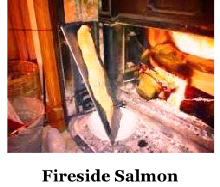 Butter - 4oz (100g)
Butter - 4oz (100g)
Garlic - 1 clove
Lemon - 1, halved
Sorrel - fresh
Plank of wood - longer than the fish fillet
Nails - 2 flat-head
I was once salmon fishing in northern British Columbia with a guide and we had been trolling all morning with good success. We landed our boats on a deserted beach and made a fire from driftwood and set about cooking a large salmon for lunch. It certainly could not have been fresher! The guide found a straight plank among the driftwood and produced a couple of nails and a hammer from his toolbox. I suspect he'd done this before! After filleting the salmon he nailed the fillet to the board, literally with a couple of nails through the shoulder of the fillet, skin side against the wood. A clove of garlic was mashed very finely and a quarter pound of butter was mixed with the garlic in a fireproof dish - we used an enamelled metal one.
Once the fire was going well the board and salmon were propped up with a stick next to the fire and regularly and generously basted with the garlic butter. The dish was placed below the fish so that the basting juices dripped back into it to be re-used. Once cooked - it's easy to see when it’s done - squeeze half a lemon on the fish and slice off chunks. Garnish with chopped fresh sorrel. Absolutely delicious! Our only problem was that we had to move on quite quickly - the smell of the cooking fish was guaranteed to attract any grizzly bears in the neighbourhood and we weren’t prepared to argue with them over whose dinner it was!
It's called Fireside Salmon for more than one reason. Not only can it be cooked al fresco but it is just as easy to cook at an open hearth fire in the home, if you are lucky enough to have a real flame coal or log fire. If not, try cooking it on the side of the barbecue. Substitute a piece of skirting board off-cut or similar plank for the driftwood and soak the plank before use to avoid it catching fire before the fish is cooked.
***